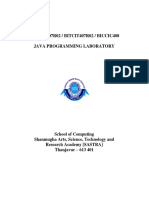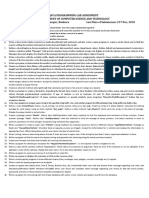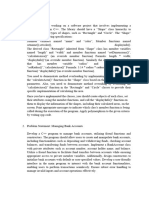LAB 5 - Inheritance
LAB 5 - Inheritance
Uploaded by
Arfaat SanitaryCopyright:
Available Formats
LAB 5 - Inheritance
LAB 5 - Inheritance
Uploaded by
Arfaat SanitaryCopyright
Available Formats
Share this document
Did you find this document useful?
Is this content inappropriate?
Copyright:
Available Formats
LAB 5 - Inheritance
LAB 5 - Inheritance
Uploaded by
Arfaat SanitaryCopyright:
Available Formats
Department of Computing
CS 212: Object Oriented
Programming
Lab 05: Inheritance
Date: 14-02-2024
Time: 9:00am- 12:00 pm
Instructor: Mr. Aimal Tariq Rextin
Lab Engineer: Engr. Masabah Bint E Islam
Name: Azka Ahmad
Reg no: 464970
CS 212: Object Oriented Programming Page 1
Lab Tasks
Reference Book: Java How to Program, 10 th Ed, Deitel & Deitel (Available on LMS)
Task# 1:
Create two classes, "Animal" and "Dog", where "Dog" extends "Animal".
The "Animal" class should have an instance variable called "name" and a method called
"speak()" that prints "An animal makes a sound" to the console.
The "Dog" class should have an instance variable called "breed" and a method called
"speak()" that prints "A dog barks" to the console.
Write a test program, create an instance of "Dog" called "myDog" and set its name to "Buddy"
and breed to "Golden Retriever". Call the "speak()" method on "myDog".
CS 212: Object Oriented Programming Page 2
Task# 2:
Design a class named Person and its two subclasses named Student and Employee. Make
Faculty and Staff subclasses of Employee.
CS 212: Object Oriented Programming Page 3
A person has a name, address, phone number, and email address. A student has a class
status (freshman, sophomore, junior, or senior). Define the status as a constant. An
employee has an office, salary, and date hired. A faculty member has office hours and a
rank. A staff member has a title. Override the toString() method in each class to display the
class name and the person’s name.
Draw the UML diagram for the classes and implement them. Write a test program that
creates a Person, Student, Employee, Faculty, and Staff, and invokes their toString()
methods.
CS 212: Object Oriented Programming Page 4
CS 212: Object Oriented Programming Page 5
Task# 3:
The following UML class diagram illustrates an inheritance relationship, wherein the
classes Circle and Rectangle have been extended from the class GeometricObject.
CS 212: Object Oriented Programming Page 6
You’re required to implement the classes GeometricObject and Rectangle.
The Rectangle class contains:
▪ Two double data fields named width and height that specify the width and height of
the rectangle. The default values are 1.0 for both width and height.
▪ A no-arg constructor that creates a default rectangle.
▪ A constructor that creates a rectangle with the specified width and height.
▪ A method named getArea() that returns the area of this rectangle.
▪ A method named getPerimeter() that returns the perimeter.
▪ A method named toString() that returns a string description for the rectangle.
The toString() method is implemented as follows:
return "Rectangle: width = " + width + " height = " + height;
Write a test program that prompts the user to enter width and height of the rectangle, a
color, and a Boolean value to indicate whether the rectangle is filled. The program should
create a Rectangle object and set the color and filled properties using the input. The
program should display the area, perimeter, color, and true or false to indicate whether it is
CS 212: Object Oriented Programming Page 7
filled or not.
CS 212: Object Oriented Programming Page 8
CS 212: Object Oriented Programming Page 9
Task# 4:
Implement the Shape hierarchy shown in below figure. Each TwoDimensionalShape should
contain method getArea to calculate the area of the two-dimensional shape. Each
ThreeDimensionalShape should have methods getArea and getVolume to calculate the
surface area and volume, respectively, of the three-dimensional shape.
CS 212: Object Oriented Programming Page 10
Create a program that uses an array of Shape references to objects of each concrete class in
the hierarchy. The program should print a text description of the object to which each array
element refers. Also, in the loop that processes all the shapes in the array, determine
whether each shape is a TwoDimensionalShape or a ThreeDimensionalShape. If it’s a
TwoDimensionalShape, display its area. If it’s a ThreeDimensionalShape, display its area and volume.
CS 212: Object Oriented Programming Page 11
CS 212: Object Oriented Programming Page 12
CS 212: Object Oriented Programming Page 13
CS 212: Object Oriented Programming Page 14
CS 212: Object Oriented Programming Page 15
You might also like
- PDF UG WBS MiniRule GetFromPricing TMRCRQ 11.1 119Document59 pagesPDF UG WBS MiniRule GetFromPricing TMRCRQ 11.1 119Abhijith RajuNo ratings yet
- Core Java AssignmentDocument11 pagesCore Java AssignmentRohit Soni50% (2)
- Write A Class Named Account To Model Accounts. The UML Diagram For The Class IsDocument2 pagesWrite A Class Named Account To Model Accounts. The UML Diagram For The Class Isflowerpot321No ratings yet
- Lab 6 OOP JAVADocument4 pagesLab 6 OOP JAVAtayyabrockstar1No ratings yet
- Objectives:: Assignment 02Document1 pageObjectives:: Assignment 02MajidNo ratings yet
- Advanced Python Practical Lab Lab code:ACSE0252 Session: 2020-21Document66 pagesAdvanced Python Practical Lab Lab code:ACSE0252 Session: 2020-21ajay prasad50% (2)
- Lab Session 4Document14 pagesLab Session 4umama amjadNo ratings yet
- CSYM025 Week 6 Lab ExercisesDocument7 pagesCSYM025 Week 6 Lab ExercisesJishnu JayachandranNo ratings yet
- Java Programming Lab Manual - Dec 2016-Apr2017Document22 pagesJava Programming Lab Manual - Dec 2016-Apr2017K SriNo ratings yet
- Lab 9 Inheritance BESE-11Document7 pagesLab 9 Inheritance BESE-11Eisha FatimaNo ratings yet
- OOP's Lab Programs QuestionsDocument4 pagesOOP's Lab Programs QuestionsBhavesh Sai DonthineniNo ratings yet
- CSE110 - OOP - Lab Assignment 02 - Student VersionDocument4 pagesCSE110 - OOP - Lab Assignment 02 - Student Versionlotif5646No ratings yet
- Practice QuestionDocument12 pagesPractice QuestionNabila bashirNo ratings yet
- Lab01 ObjectAndClassDocument14 pagesLab01 ObjectAndClassMUHAMMAD RAFZAN ARMANNo ratings yet
- EojwoDocument9 pagesEojwoAsdf 9482No ratings yet
- IGNOU MCA MCSL 025 Java Part SolvedDocument49 pagesIGNOU MCA MCSL 025 Java Part Solvedfajer007100% (4)
- Tutorial 4 Classes and Objects: 1. Java Api Has The Gregoriancalendar Class in The Java - Util Package, WhichDocument5 pagesTutorial 4 Classes and Objects: 1. Java Api Has The Gregoriancalendar Class in The Java - Util Package, WhichMr. XNo ratings yet
- List of Programs Adv PythonDocument5 pagesList of Programs Adv PythonNEVER SETTLENo ratings yet
- Core Java Programming Lab Assignments: Introduction To Java (Day 1,2)Document11 pagesCore Java Programming Lab Assignments: Introduction To Java (Day 1,2)kuldeepNo ratings yet
- C++ Lab ManualDocument26 pagesC++ Lab ManualAshwini LakkasNo ratings yet
- Lab Manual - 2023-24Document6 pagesLab Manual - 2023-24nogati3383No ratings yet
- List of Practicals OOPDocument2 pagesList of Practicals OOPSubhanshu MathurNo ratings yet
- Lab 03Document5 pagesLab 03Muhammad Zubair AfridiNo ratings yet
- CS2209 Oops LabDocument79 pagesCS2209 Oops Labtp2006sterNo ratings yet
- Oops Front PageDocument8 pagesOops Front PageAkash DograNo ratings yet
- Java Assignments 5th SemDocument2 pagesJava Assignments 5th SemKrishanu NaskarNo ratings yet
- Core Java Assignments Lab 3Document11 pagesCore Java Assignments Lab 3Gurjar Devyani25% (4)
- 65 Fa 911 e 323 B 3 Assignment 1Document1 page65 Fa 911 e 323 B 3 Assignment 1bscs23f06No ratings yet
- LAB02 Chapter 06 (A First Look at Classes) - Part 2 - 2Document10 pagesLAB02 Chapter 06 (A First Look at Classes) - Part 2 - 2Muhanad AhmadNo ratings yet
- OopcglDocument59 pagesOopcglhuks7781No ratings yet
- Sree Muthukumaraswamy College: Department of Bca Object Oriented Programming Using C++ LabDocument61 pagesSree Muthukumaraswamy College: Department of Bca Object Oriented Programming Using C++ Labdarunraj365No ratings yet
- JAVA Programming Lab AssignmentsDocument4 pagesJAVA Programming Lab AssignmentsRichaNo ratings yet
- Noida Institute of Engineering and TechnologyDocument47 pagesNoida Institute of Engineering and TechnologyAayush KumarNo ratings yet
- Assignment 1Document5 pagesAssignment 1RasDanyNo ratings yet
- Object Oriented Design and Analysis: RemarksDocument2 pagesObject Oriented Design and Analysis: RemarksRabiulAlamNo ratings yet
- Unit 3 - Week1Document2 pagesUnit 3 - Week1vinith gomezNo ratings yet
- Oops Lab VaseemDocument41 pagesOops Lab VaseemMohd. VaseemNo ratings yet
- Oop Lop New ItDocument6 pagesOop Lop New ItSuresh KumarNo ratings yet
- Sumit_Kumar_R_practical_20241211_163149_0000Document24 pagesSumit_Kumar_R_practical_20241211_163149_0000nain09364No ratings yet
- Exam OOP 2021Document2 pagesExam OOP 202110422017No ratings yet
- ES203 Practical Workbook OOP C++Document22 pagesES203 Practical Workbook OOP C++shivam kumar sinhaNo ratings yet
- Java Assignment 2018 - 3rd Year-1Document1 pageJava Assignment 2018 - 3rd Year-1Ankita KunduNo ratings yet
- 43 Ce Shreyash Patel 1 3140705 Oop I Lab ManualDocument36 pages43 Ce Shreyash Patel 1 3140705 Oop I Lab ManualShreyash PatelNo ratings yet
- Cycle QuestionsDocument7 pagesCycle QuestionsSreehari SajiNo ratings yet
- Java Lab Manul - MergedDocument115 pagesJava Lab Manul - MergedHarsh JhaNo ratings yet
- Problem Set - OOPDocument4 pagesProblem Set - OOPkamruzaman shuvoNo ratings yet
- Lab-07 Muneeb Asif 334492Document13 pagesLab-07 Muneeb Asif 334492Muneeb AsifNo ratings yet
- S58798 LabSession1Document14 pagesS58798 LabSession1Yi YinNo ratings yet
- Lab Manual OOPDocument19 pagesLab Manual OOPAmit Bagrecha100% (1)
- Unit-3 - Practical AssignmentDocument3 pagesUnit-3 - Practical Assignmentyashuop46No ratings yet
- Riphah International University I-14 Main Campus Faculty of ComputingDocument2 pagesRiphah International University I-14 Main Campus Faculty of ComputingRafay Kazmi50% (2)
- Java Exercises Set1Document4 pagesJava Exercises Set1P Poorna Chander ReddyNo ratings yet
- List of Programs UpdatedDocument3 pagesList of Programs UpdatedAnirban MukherjeeNo ratings yet
- C++ Programming Lab Manual: Sri Indu Institute of Engineering &technologyDocument45 pagesC++ Programming Lab Manual: Sri Indu Institute of Engineering &technologyHimesh KrishnanNo ratings yet
- I Bca CPP Record Programs Using Dev CPPDocument34 pagesI Bca CPP Record Programs Using Dev CPPkavi333567No ratings yet
- L9. Math Object in JS, CSE 202, BN11Document13 pagesL9. Math Object in JS, CSE 202, BN11Saurav BaruaNo ratings yet
- 10Document3 pages1020UCA519 EswarNo ratings yet
- Oop Lab Manual Final-1Document59 pagesOop Lab Manual Final-1आशीष कुमार सालवी0% (1)
- Java CycleDocument2 pagesJava CyclePranav SanthoshNo ratings yet
- AutoCAD 2019: A Problem - Solving Approach, Basic and Intermediate, 25th EditionFrom EverandAutoCAD 2019: A Problem - Solving Approach, Basic and Intermediate, 25th EditionNo ratings yet
- Lec 9 Arrays and ArrayListDocument23 pagesLec 9 Arrays and ArrayListArfaat SanitaryNo ratings yet
- Lecture # 11 (Continuous Functions and Introduction To Derivatives)Document35 pagesLecture # 11 (Continuous Functions and Introduction To Derivatives)Arfaat SanitaryNo ratings yet
- Lecture # 13 (Derivatives)Document42 pagesLecture # 13 (Derivatives)Arfaat SanitaryNo ratings yet
- 1.1-Introduction DB v2Document55 pages1.1-Introduction DB v2Arfaat SanitaryNo ratings yet
- Dldlab6 justPreLabDocument10 pagesDldlab6 justPreLabArfaat SanitaryNo ratings yet
- Assignment 2Document7 pagesAssignment 2Arfaat SanitaryNo ratings yet
- HP Notebook 15-db1079nm: Quality Performance and A Long-Lasting Battery To Tackle Every Day TasksDocument3 pagesHP Notebook 15-db1079nm: Quality Performance and A Long-Lasting Battery To Tackle Every Day Taskssupersrbin20065023No ratings yet
- Chapter 3 - Choppers - PDFDocument75 pagesChapter 3 - Choppers - PDFZahidullah100% (1)
- Armstrong Design Envelope PumpsDocument20 pagesArmstrong Design Envelope Pumpsrijothomasv777No ratings yet
- ThinPrep® Genesis™ Processor Brochure GBR ENDocument3 pagesThinPrep® Genesis™ Processor Brochure GBR ENJösêii ChâmörröNo ratings yet
- KUTO VPN For Android - Download The APK From UptodownDocument1 pageKUTO VPN For Android - Download The APK From Uptodownjeccampos9No ratings yet
- Set Up ONTAPDocument20 pagesSet Up ONTAPBranislav KrivokapicNo ratings yet
- Comput Fluid Dynamics PDFDocument853 pagesComput Fluid Dynamics PDFJinoyVargheseTharu100% (1)
- Linux XDMCP Howto: Thomas ChaoDocument16 pagesLinux XDMCP Howto: Thomas ChaoHuynh DaveNo ratings yet
- Electronic Resources For University Library and Its Advantages2Document12 pagesElectronic Resources For University Library and Its Advantages2Ahmed MahmoudNo ratings yet
- Multiple FactoryTalk View SE Applications Within A Single FactoryTalk DirectoryDocument4 pagesMultiple FactoryTalk View SE Applications Within A Single FactoryTalk Directoryksahil2410No ratings yet
- Supriya ResumeDocument7 pagesSupriya ResumePiyush SahuNo ratings yet
- Rose and Rocky Go GreenDocument15 pagesRose and Rocky Go Greenms.pv.b.edNo ratings yet
- MODEL EXAM OE 3DP Set 2Document2 pagesMODEL EXAM OE 3DP Set 2karanNo ratings yet
- EMC Directive StandardsDocument11 pagesEMC Directive StandardsbpkojaNo ratings yet
- GMR Nottingham K Ficha TecnicaDocument7 pagesGMR Nottingham K Ficha TecnicaVictor Manuel Bocanegra GarciaNo ratings yet
- BC3-20 - 2.1 - Student AssessmentDocument10 pagesBC3-20 - 2.1 - Student AssessmentDiana zuluagaNo ratings yet
- Daa FinalDocument15 pagesDaa FinalDarkroomNo ratings yet
- Continuous OptimizationDocument51 pagesContinuous Optimizationlaphv494No ratings yet
- ICST 2025 Brochure - 18 Oct 2024Document7 pagesICST 2025 Brochure - 18 Oct 2024pa924107No ratings yet
- 1 Operating System Part 1Document17 pages1 Operating System Part 1Breaking News 247No ratings yet
- Website Analysis & Insights - October 2022Document6 pagesWebsite Analysis & Insights - October 2022ROBERTO LOZANO HERNANDEZNo ratings yet
- Sacramento State Level 1 Systems Access Review TemplateDocument4 pagesSacramento State Level 1 Systems Access Review TemplateMaxedus DotaNo ratings yet
- Sanmateoco 0704Document5 pagesSanmateoco 0704api-345566077No ratings yet
- NO Nama / Nip Tempat/ TGL Lahir 1 2 3Document46 pagesNO Nama / Nip Tempat/ TGL Lahir 1 2 3Abell Riefqi SunariyantoNo ratings yet
- Research Methods for Computer Science - CopyDocument16 pagesResearch Methods for Computer Science - CopyNick LunguNo ratings yet
- Module 1_Chapter 1-An-Overview-of-Java-notes (1)Document8 pagesModule 1_Chapter 1-An-Overview-of-Java-notes (1)Prathima MahapurushNo ratings yet
- Neural Networks - Lecture NotesDocument20 pagesNeural Networks - Lecture NotesdvarsastryNo ratings yet
- Data Acquisition Toolbox Release NotesDocument48 pagesData Acquisition Toolbox Release NotesJAMER OSWALDO CHALA RAMIREZNo ratings yet
- Vpnclient Windows 5.0.03Document3 pagesVpnclient Windows 5.0.03api-3852649100% (1)































































































